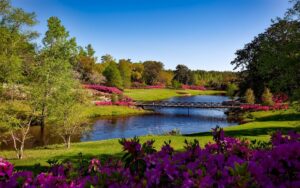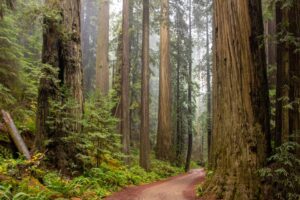Summer in Zion National Park is busy, and crowds are common almost everywhere you go. Standing in long lines and sharing trails with hundreds of other visitors can quickly take away from the natural beauty you came to experience. You can avoid the biggest crowds at Zion by planning ahead and choosing the right times and places to explore.
You do not have to settle for packed shuttles or busy viewpoints on your trip. There are several proven strategies that will help you find quieter spots and enjoy peaceful moments, even during the busiest summer days. If you want your Zion adventure to feel more personal and less crowded, keep reading to find out how you can make it happen.
Best Times to Visit for Solitude
Staying away from the crowds in Zion National Park takes careful planning. The time of day and the day of the week affect how many people you’ll see on trails and at shuttle stops.
Early Morning Advantages

Arriving early gives you the quietest experience. Most people enter the park after 9 am, so by coming before then, you get to enjoy empty shuttle buses and less crowded viewpoints.
Hiking in the early morning also means cooler temperatures, especially important in the summer. The heat can be intense, but starting at sunrise keeps you comfortable and safe. You can often finish popular hikes like Angels Landing or the Narrows before crowds build up.
The wildlife is more active before noon. Birds, deer, and even bighorn sheep are easier to spot when the trails are still and quiet. You will also have better opportunities for photos without groups of people in your shot.
Late Afternoon and Evening Visits
Visiting Zion in the late afternoon or after 4 pm brings smaller crowds. Many day visitors and families leave by mid-afternoon, so you’ll find parking easier and wait times for shuttles are much shorter.
The lighting is better for photos as the sun starts to set, and the temperature drops enough to make even the exposed trails more pleasant. Sunset in the canyon is a beautiful time—reds and oranges glow on the cliffs, and there is less noise.
Many popular trails, like Emerald Pools and Riverside Walk, empty out later in the day. Trails become quieter, and you’ll get a more peaceful hike without needing to move aside for group after group. According to several visitors, hiking after 4 pm can be just as good as early mornings for avoiding peak crowds.
Weekday Versus Weekend Crowds
Crowds increase on weekends, especially during summer and holiday weeks. If you visit on a weekday, you will see far fewer people at shuttle stops, on trails, and at scenic overlooks.
Monday through Thursday tend to have the lowest attendance. Many local schools are still in session in early June, and families typically travel Friday through Sunday, making those days.
If possible, avoid national holidays and special events. By picking less busy weekdays, you can enjoy longer stretches of quiet and even find some solitude on the most popular hikes.
Hidden Gems and Quiet Trails

Several lesser-known areas in Zion National Park offer peaceful scenery and fewer visitors. Trails in these spots reveal beautiful landscapes, unique geology, and a chance to experience Zion without the crowds.
Exploring Kolob Canyons
Kolob Canyons sits in Zion’s northwest corner, about 40 miles from the main canyon. The area stands out for its towering red cliffs, deep canyons, and quiet trails. You can hike the Taylor Creek Trail, a 5-mile round trip that leads into a narrow box canyon and past two historic cabins.
The Kolob Arch Trail is another highlight, where you can see one of the world’s largest natural arches. Since Kolob Canyons has a separate entrance, you won’t have to deal with the busy main park shuttle system. It’s often much less crowded, especially during peak summer months. Facilities are basic, but there is a visitor center and a scenic drive ideal for photo stops.
Less-Traveled East Side Routes
Zion’s east side, accessed through the Zion-Mount Carmel Highway, offers a different look at the park with slickrock, pine forests, and winding trails. The East Rim Trail and Deertrap Mountain are two options where you may only see a handful of other hikers.
The East Rim Trail leads to dramatic overlooks and quiet canyon scenery away from the main valley. Deertrap Mountain rewards you with panoramic views of Zion Canyon far below. For a much shorter walk, try the Canyon Overlook Trail early or late in the day for solitude and sunrise or sunset colors.
These east side hikes don’t require the shuttle, so you can start early. The terrain is more open, making route-finding easier, but bring plenty of water and sun protection.
Canyoneering in Remote Locations

If you want a more adventurous way to beat the crowds, try canyoneering in one of Zion’s many slot canyons. Remote spots like Shelf Canyon and Water Canyon offer tight narrows, cool shade, and peaceful settings. These routes require basic climbing or rappelling skills, and many sections are not marked, so you should have experience or go with a guide.
Canyoning trips take you far away from the main trails. You’ll hike, scramble, and wade through deep rock corridors, seeing arches and pools tourists rarely reach. Always check weather conditions because flash floods are a risk, even on clear days. Some remote canyons, including those near Kolob, let you explore quiet trails and hidden gems where you might spend hours without meeting another person.
Bring proper gear, get required permits, and be ready for a true wilderness experience.
Alternative Park Entrances and Access Points
Many visitors use only the main south entrance at Zion, which leads to long lines and busy parking lots. Picking a lesser-used entrance can help you save time, find parking more easily, and enjoy quieter hiking areas.
Benefit of the Kolob Terrace Road
Kolob Terrace Road is a less popular route into Zion. You access it west of Springdale, through the small town of Virgin.
This entrance helps you avoid heavy traffic seen at Zion Canyon. The area is known for scenic drives and wide-open views. Trailheads like the West Rim Trail and Hop Valley Trail start here, offering options for both short walks and longer backpack trips.
Kolob Terrace Road stays quieter even in the busy summer months. There are no shuttle buses, and fewer crowds, which means you can move at your own pace. The higher elevation also brings cooler temperatures, especially helpful in the heat. Facilities are basic—bring water, food, and a full tank of gas since services are limited.
If you want to focus on photography, wildlife watching, or uncrowded hiking, Kolob Terrace Road is a strong choice.
East Entrance Opportunities

The east entrance is less busy compared to the main south entrance. It brings you through a more remote part of Zion, closer to Kanab.
You drive through the historic Zion-Mount Carmel Tunnel to reach the park’s east side. The road itself winds past colorful sandstone, vast plateaus, and pine forests. You find trailheads like Canyon Overlook and Checkerboard Mesa here. These spots are often much less crowded.
Staying outside the park in towns such as Kanab puts you near the east gate. From here, you may avoid shuttles and crowds in Zion Canyon, especially in early mornings or on weekdays.
Parking fills more slowly at the east entrance. This allows you to start your day early and enjoy sunrise or wildlife activity in peace. The east side is also known for excellent photo opportunities, thanks to unique rock formations and wide vistas.
Smart Itineraries for Avoiding Crowds
You can see Zion National Park with fewer people by adjusting the time and order of your hikes. By heading to places at the right hours and avoiding peak times, you get better views and more space.
Planning Early and Late Hikes
Starting your hike at sunrise gives you a quiet trail and cooler temperatures. The shuttles at Zion begin running before many visitors are awake, so you can use this to reach popular spots first. Evening hikes also help you dodge the most crowded hours, offering softer light for photos and milder weather.
Some trails are especially good for early or late starts. The Watchman Trail, for example, lights up at sunrise and is often less busy than Angel’s Landing. Consider these tips for better timing:
- Arrive before 7 AM or after 4 PM for main trails.
- Use less popular paths like East Mesa Trail to Observation Point, where you can beat the crowds.
With these small changes, your hikes can be more peaceful and enjoyable.
Staggering Visits to Popular Spots
Midday is usually busiest, so visit high-traffic areas like The Narrows, Emerald Pools, or Angel’s Landing either early in the morning or late in the day. If you visit attractions outside standard hours, you spend less time waiting and more time exploring.
Split your itinerary by adding visits to quieter sections, such as Kolob Canyons or Taylor Creek Trail. These offer beautiful scenery and shorter waits. Pair these side trips with shorter breaks in the main canyon during busy hours.
Here’s a sample plan:

Mixing up your routine and spreading out visits keeps your days full but not crowded.
Transportation and Parking Strategies
Arriving early and knowing where to park can save you time and reduce stress. Using the Zion shuttle system is essential for reaching many trailheads during summer because private vehicles are not allowed past a certain point.
Utilizing the Shuttle System Off-Peak
The Zion Canyon Shuttle is the main way to access most of the park’s famous hikes and landmarks. In summer, lines can be long during the middle of the day. To avoid the worst waits:
- Get to the shuttle stop early in the morning, ideally before 8:00 AM.
- Late afternoon, after 5:00 PM, usually has shorter lines.
- Check the current shuttle schedule and stops because they may change.
Planning your stops ahead can also save time. Decide which hikes or viewpoints are most important and avoid hopping on and off too often. If possible, visit less crowded spots or go east of the tunnel to escape the busiest areas. Carry water and snacks, since you might wait longer than expected if crowds grow.
Parking Tips for Busy Days

Parking inside Zion fills up quickly, especially during summer. If you cannot find a spot at the visitor center, do not wait or block traffic. Instead, park in the nearby town of Springdale and use the local Springdale Shuttle to reach the park entrance.
Follow these tips for smoother parking:
- Only park in marked, legal parking areas.
- Never park on vegetation, in the road, or block any driveway.
- Arrive early for the best parking options.
If lots are full when you arrive, head directly to Springdale rather than circling the park. Remember, parking violations can result in tickets or towing. Having a plan before you arrive helps you start your day in the park sooner and with less hassle.
Accommodation Options Away from Main Areas
Choosing where to stay outside Zion’s busiest zones lets you experience quieter evenings, easier parking, and local restaurants without the crowds. Different nearby towns offer good access to trails, scenic views, and extra amenities.
Staying in Springdale

Springdale sits right outside Zion’s main entrance, but you can avoid the heaviest crowds by picking spots on the edge of town or farther from shuttle stops. Many hotels and vacation rentals are nestled along the Virgin River or tucked against canyon walls, offering you more privacy and great views.
Options like Cable Mountain Lodge, Cliffrose, and small bed-and-breakfasts often fill up, so book early for the best selection. Many properties have shuttle stops but also allow you to walk or bike into the park. Quiet hours are enforced at most places, so late-night noise is rare.
Springdale features local dining, small grocery stores, and outdoor gear shops. You’ll also find art galleries, coffee shops, and places to relax after hiking. For a mix of comfort and convenience close to Zion—but just far enough from the main crowds—Springdale remains a popular pick with a lot of variety.
Lodging in Virgin and La Verkin
Virgin and La Verkin are west of Zion and offer a quieter experience with lower prices and less traffic. These small towns have motels, vacation homes, and even glamping sites. You’ll be about 20 to 30 minutes from the park’s entrance, but you can skip the busiest sections near the main gate.
Virgin is known for scenic views and peaceful sunrises. You can find unique places to stay, like cabins or tiny homes, that are set apart from busy roads. La Verkin features easy access to local restaurants, basic shops, and the Kolob Terrace Road, a less-crowded park entry route.
This area is best for those who want more space, less noise, and a slower pace. You can learn more and see reviews of these options at accommodation guides for Zion National Park and detailed lists of places near Zion.




